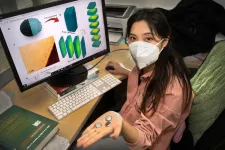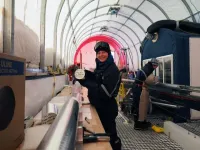(Press-News.org) North Carolina State University researchers have developed a computer simulation tool to predict when and where pests and diseases will attack crops or forests, and also test when to apply pesticides or other management strategies to contain them.
"It's like having a bunch of different Earths to experiment on to test how something will work before spending the time, money and effort to do it," said the study's lead author Chris Jones, research scholar at North Carolina State University's Center for Geospatial Analytics.
In the journal Frontiers in Ecology and the Environment, researchers reported on their efforts to develop and test the tool, which they called "PoPS," for the Pest or Pathogen Spread Forecasting Platform. Working with the U.S. Department of Agriculture's Animal and Plant Health Inspection Service, they created the tool to forecast any type of disease or pathogen, no matter the location.
Their computer modeling system works by combining information on climate conditions suitable for spread of a certain disease or pest with data on where cases have been recorded, the reproductive rate of the pathogen or pest and how it moves in the environment. Over time, the model improves as natural resource managers add data they gather from the field. This repeated feedback with new data helps the forecasting system get better at predicting future spread, the researchers said.
"We have a tool that can be put into the hands of a non-technical user to learn about disease dynamics and management, and how management decisions will affect spread in the future," Jones said.
The tool is needed as state and federal agencies charged with controlling pests and crop diseases face an increasing number of threats to crops, trees and other important natural resources. These pests threaten food supplies and biodiversity in forests and ecosystems.
"The biggest problem is the sheer number of new pests and pathogens that are coming in," Jones said. "State and federal agencies charged with managing them have an ever-decreasing budget to spend on an ever-increasing number of pests. They have to figure out how to spend that money as wisely as possible."
Already, researchers have been using PoPS to track the spread of eight different emerging pests and diseases. In the study, they described honing the model to track sudden oak death, a disease that has killed millions of trees in California since the 1990s. A new, more aggressive strain of the disease has been detected in Oregon.
They are also improving the model to track spotted lanternfly, an invasive pest in the United States that primarily infests a certain invasive type of tree known as "tree of heaven." Spotted lanternfly has been infesting fruit crops in Pennsylvania and neighboring states since 2014. It can attack grape, apple and cherry crops, as well as almonds and walnuts.
The researchers said that just as meteorologists incorporate data into models to forecast weather, ecological scientists are using data to improve forecasting of environmental events - including pest or pathogen spread.
"There's a movement in ecology to forecast environmental conditions," said Megan Skrip, a study co-author and science communicator at the Center for Geospatial Analytics. "If we can forecast the weather, can we forecast where there will be an algal bloom, or what species will be in certain areas at certain times? This paper is one of the first demonstrations of doing this for the spread of pests and pathogens."
INFORMATION:
The study, "Iteratively Forecasting Invasions with PoPS and a Little Help From Our Friends," was published June 3, 2021, in the journal Frontiers in Ecology and the Environment. It was authored by Chris Jones, Shannon Jones, Anna Petrasova, Vaclav Petras, Devon Gaydos, Megan Skrip, Yu Takeuchi, Kevin Bigsby and Ross Meentemeyer. It was partially funded by the National Science Foundation as part of the NSF-NIH Ecology and Evolution of Infectious Diseases Program, as well as Google Cloud and NVIDIA.
Note to editors: An abstract follows.
"Iteratively Forecasting Invasions with PoPS and a Little Help From Our Friends"
DOI:
Published: June 3, 2021, in Frontiers in Ecology and the Environment
Authors: Chris Jones, Shannon Jones, Anna Petrasova, Vaclav Petras, Devon Gaydos, Megan Skrip, Yu Takeuchi, Kevin Bigsby and Ross Meentemeyer
Abstract: Ecological forecasting has vast potential to support environmental decision-making with repeated, testable predictions across management-relevant timescales and locations. Yet, resource managers rarely are engaged to co-design forecasting systems or embed them in decision-making. Predicting the outcomes of planned management is particularly important for biological invasions, to optimize when and where to allocate resources. Yet, spatial-temporal models of spread have not typically been openly shared, iteratively updated, or interactive to allow exploring management actions. We describe a species-agnostic, open-source framework -- called the PoPS (Pest or Pathogen Spread) Forecasting Platform -- for co-designing near-term iterative forecasts of biological invasions. Two case studies demonstrate that iterative calibration yields higher forecast skill than using only the earliest-available data to predict future spread. The PoPS framework is a primary example of an ecological forecasting system that has been both scientifically improved and optimized for real-world decision-making through sustained participation and use by management stakeholders.
KINGSTON, R.I. - June 3, 2021 - Scientists from the University of Rhode Island have taken the first steps toward understanding the function of microbes that live on and in Eastern oysters, which may have implications for oyster health and the management of oyster reefs and aquaculture facilities.
"Marine invertebrates like oysters, corals and sponges have a very active microbiome that could potentially play a role in the function of the organism itself," said Ying Zhang, URI associate professor of cell and molecular biology. "We know very little about whether there are resident microbes in oysters, and if there are, what their function may be or how they may help or bring harm to the oyster."
Zhang and doctoral student Zachary Pimentel extracted the DNA of microbes living in ...
ANN ARBOR, Mich. -- A different type of surge may be on the way more than a year into the pandemic - a baby surge.
The COVID-19 shutdown initially seemed to hit pause on pregnancy and birth rates, new research from one major hospital system suggests, but that trend is quickly reversing.
"Birth rates declined early on in the pandemic, but we expect a dramatic rebound soon," says lead author Molly Stout, M.D., MSci, maternal fetal medicine director at Michigan Medicine Von Voigtlander Women's Hospital.
"We're already seeing signs of a summer baby surge."
While infectious ...
UPTON, NY--A team of researchers led by chemists at the U.S. Department of Energy's (DOE) Brookhaven National Laboratory has studied an elusive property in cathode materials, called a valence gradient, to understand its effect on battery performance. The findings, published in Nature Communications, demonstrated that the valence gradient can serve as a new approach for stabilizing the structure of high-nickel-content cathodes against degradation and safety issues.
High-nickel-content cathodes have captured the attention of scientists for their high capacity, a chemical property that could power electric vehicles over much longer distances than current batteries support. Unfortunately, the high nickel content also causes these cathode materials to degrade more quickly, creating cracks ...
The South Pole and the rest of East Antarctica is cold now and was even more frigid during the most recent ice age around 20,000 years ago -- but not quite as cold as previously believed.
University of Washington glaciologists are co-authors on two papers that analyzed Antarctic ice cores to understand the continent's air temperatures during the most recent glacial period. The results help understand how the region behaves during a major climate transition.
In one paper, an international team of researchers, including three at the UW, analyzed seven ice cores from across West and East Antarctica. The results published June 3 in Science show warmer ice age temperatures in the eastern part of the continent.
The team ...
Scientists have gained the best view yet of the brightest explosions in the universe: A specialised observatory in Namibia has recorded the most energetic radiation and longest gamma-ray afterglow of a so-called gamma-ray burst (GRB) to date. The observations with the High Energy Stereoscopic System (H.E.S.S.) challenge the established idea of how gamma-rays are produced in these colossal stellar explosions which are the birth cries of black holes, as the international team reports in the journal Science.
"Gamma-ray bursts are bright X-ray and gamma-ray flashes observed in the sky, emitted by distant extragalactic sources," explains DESY scientist Sylvia Zhu, one of the authors of the ...
The biggest shark attack in history did not involve humans.
A new study by Earth scientists from Yale and the College of the Atlantic has turned up a massive die-off of sharks roughly 19 million years ago. It came at a period in history when there were more than 10 times more sharks patrolling the world's oceans than there are today.
For now, researchers don't know the cause of the shark die-off.
"We happened upon this extinction almost by accident," said Elizabeth Sibert, a Hutchinson postdoctoral associate in Yale's Department of Earth and Planetary Sciences and ...
Scientists have developed the first cells that can construct artificial polymers from building blocks that are not found in nature, by following instructions the researchers encoded in their genes.
The study, led by scientists from the Medical Research Council (MRC) Laboratory of Molecular Biology, in Cambridge, UK, also found the synthetic genome made the bacteria entirely resistant to infection by viruses.
The scientists say their research could lead to the development of new polymers - large molecules made of many repeating units, such as proteins, plastics, and many drugs including antibiotics - and make it easier to ...
Hydrogels are polymer materials made mostly from water. They can be used in a wide range of medical and other applications. However, previous incarnations of the materials suffered from repeated mechanical stress and would easily become deformed. A novel crystal that can reversibly form and deform, allows hydrogels to rapidly recover from mechanical stress. This opens up the use of such biocompatible materials in the field of artificial joints and ligaments.
Many of us suffer the occasional sports injury or experience some kind of pain relating to joints and ligaments at some point in our lives. ...
Researchers from University of Toronto Engineering have developed an improved electrochemical system that raises the value of captured CO2 by converting more of it into valuable products than ever before.
The International Energy Agency recently cited carbon capture and storage as one of the strategies that can help keep global emissions low enough to limit global warming to 1.5 C by 2050. But captured carbon currently has little economic value, reducing the incentive for companies to invest in this technology.
A University of Toronto Engineering team led by Professor Ted Sargent is addressing this challenge by designing advanced electrolyzers that use electricity to convert captured CO2 into the petrochemical building blocks of common everyday materials, ...
An engineering researcher from the University of Sydney, in collaboration with a team at the University of Toronto, has developed an electrochemical system that coverts a greater amount of CO2 into valuable products.
The International Energy Agency recently cited carbon capture and storage as a strategy that can help keep global emissions low enough to limit global warming to 1.5°C by 2050. However, captured carbon currently has little economic value, reducing the incentive for companies to invest in this technology.
The team of researchers has addressed this challenge by designing advanced electrolysers - machines using electricity to convert captured CO2, plus water, into the building blocks of common everyday materials, ...



